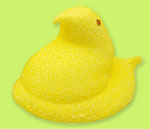Easter Peeps: Tasty Marshmallowy Goodness

The History of Everybody’s Favorite Candy
During the Easter season, Americans will enjoy an estimated 700 million Peeps, that sweet marshmallow candy shaped like a chick or bunny. With those kinds of numbers, it’s no wonder Peeps are billed as America’s favorite candy.
Are you a Peeps fan? Have you ever been curious about Peeps history? Where they came from and how they developed into the ultimate Easter treat? Just read on!
Nearly a century ago, a young Russian-born man named Sam Born was living in France, where he learned the fine art of chocolate making. Sam immigrated to the United States in 1910. Seven years later, he opened a small candy shop in New York City, where he not only sold sweets, but made them, too.
As Born’s operations outgrew his store, he moved his company, by then coined Just Born, out of New York City to Bethlehem, Pennsylvania.
That’s right: Bethlehem! First, the birthplace of Easter’s superstar, and then (much) later, the site of the most popular treat eaten in his honor.
In the mid 1950s, Just Born acquired another company that had invented a three-dimensional marshmallow mold that turned out Easter chicks and bunnies, called Peeps. With some fine-tuning of their assembly line and clever marketing, Born had an Easter hit on his hands.
But why was the chick and rabbit so appealing? How did those particular animals-albeit sugary ones-so quickly become adopted as the symbols for Easter?
Interestingly, Just Born was based in Pennsylvania, which was also home to America’s largest community of German immigrants who are largely credited with popularizing the Easter Bunny tradition in America.
In the 19th century, German children would eagerly await the arrival of the Oschter Haws, a rabbit who delighted children on Easter morning by laying colored eggs in nests. The Germans expanded this tradition into the Easter egg basket, delivered by a hopping bunny.
While the symbolism of the Easter bunny might be rather obvious, the chick question requires one to dig a little deeper. And to ask the perennial question: Which came first? The chicken? Or the egg?
Historians have long speculated that the egg was actually a Pagan symbol of fertility and rebirth, first associated with ancient equinox festivals, whose traditions were later folded into the Christian Easter. It stands to reason, then, that the chick would be a natural byproduct of this egg-y fertility.



